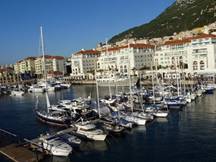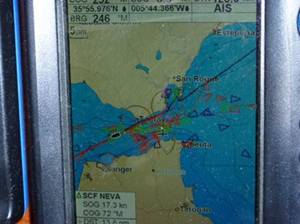FW: leaving Gibraltar

|
Gibraltar-Las Palmas
Passage
Distance:
~750 NM 02/11/2010
Distance: ~134 NM
“35:03N 07:51W” At last the morning has arrived of our first passage. We have been
impatiently waiting for it, as the extra day in
The AIS (Automatic Information System) which gives us the details
of all ships in the neighborhood was beeping almost constantly, warning that we
were just about to run over by a container ship, a fast ferry or an oil tanker.
We were definitely in the way of the Tarifa-Tangier ferries that made three
good efforts to run us down at 35 knt speed. Now, while I cannot say that
ferries are commissioned to hunt for sailing boats, they are known not to
change their course, so it’s advisable for anyone in their way to run for
their life. Eventually with skillful maneuvering and some luck we avoided the
ferries and couple of large container ships like the one called But our main problem was that we slowed right down. There are all sorts
of beliefs associated with the On this day the current disregarded the theories about flows in an out
of the Med and definitely did not follow the rules of the tide tables. The
wind, straight on the nose, was also uncooperative. Thus, with full steam we
were just crawling across the Mid-stream section for 4-5 hrs. Around 3.30
finally we cleared Cabo Espartel and slowly the 100HP Volvo started to make a
difference and we slowly accelerated. The wind slowly picked up and we started
to motor sail. By 18.00 we were flying at broad reach with 8-8.3 kts! We have all heard and thought about “Sailing into the
sunset” so much,now, here we were doing it. The reddish low sky with the
glowing sun was so inviting that we followed it without hesitation until the
sun disappeared on the horizon. Mark cooked a great curry. We were so busy with
sailing and admiring the sunset that it was pitch dark by the time we served
the curry. It was a moonless night. Incredibly black. Against this
background the stars put on a great show and our home galaxy, the Milky Way was
clearly shining above us. The satellites and airplanes, usually the brightest
objects on the night sky, were faintly glowing among the millions of brilliant
winkling stars. The night sky looked like a dazzling Tiffany store decorated
with sparkling diamonds. Somehow the guys did not like this comparison. I
cannot imagine why? We started our “official” watches: 23-01 Liz; 01-03 Steve;
03-05 Kynan; 05-07 Mark. It was a great night sailing until 02 am when the seas
became very confused and the wind direction changed. We were thrown around
quite a bit with the main sail up only and but were reluctant to do a full
down-wind set up in the dark on our first day at sea. One newly installed water hose developed a leak and sprinkled water all
over the engine room and as a surprising, very disappointing development our
800 Ah battery bank was struggling to cope with Fenix’s night show:
lights, computer chart plotter, Navman chart plotter, radar, instruments,
navigations lights, VHF radio, fridge, and auto pilot. Probably it didn’t
help that during the winter the batteries went flat though we paid the yard for
charging them. So we had to start preserving electricity. What a pain! But,
changing the Giro compass fixed our autopilot. |





